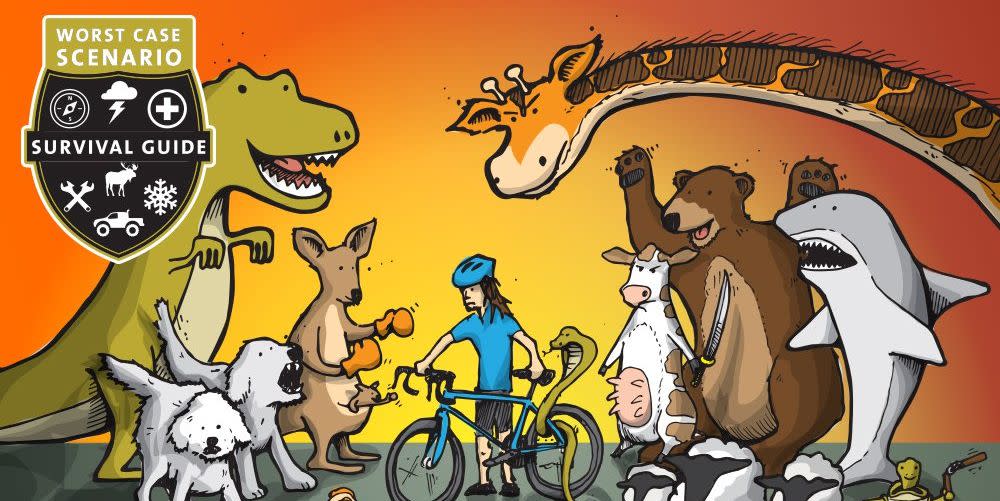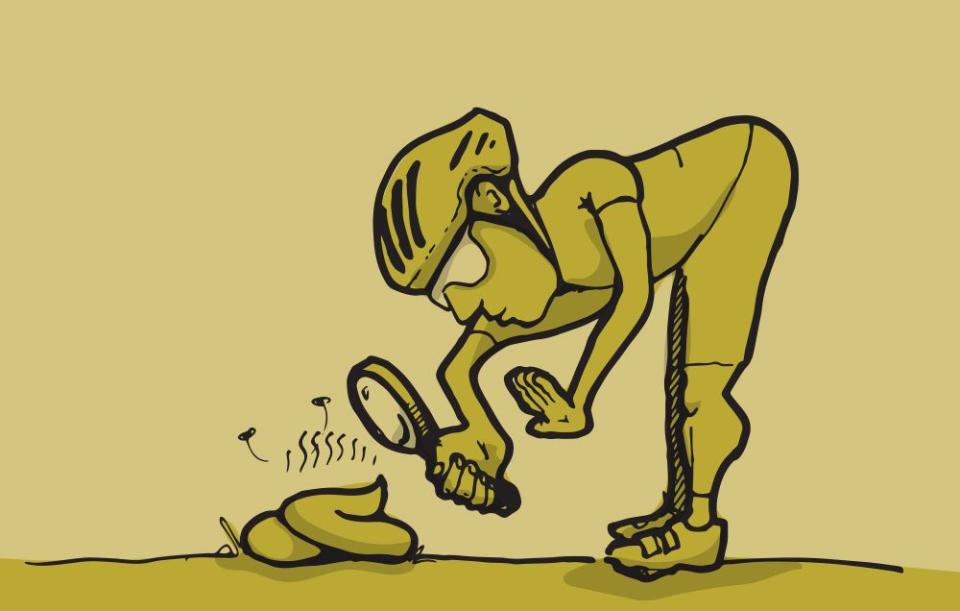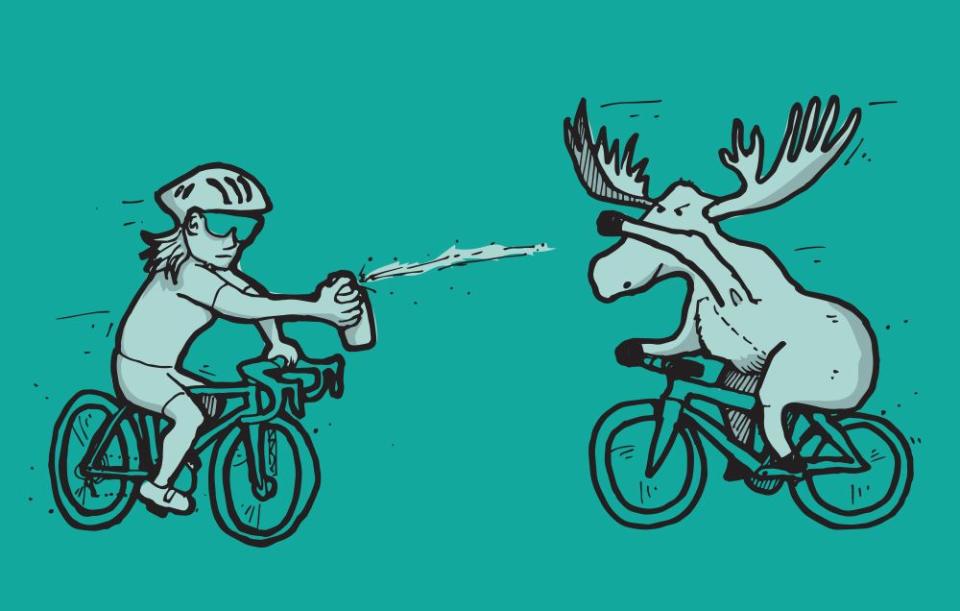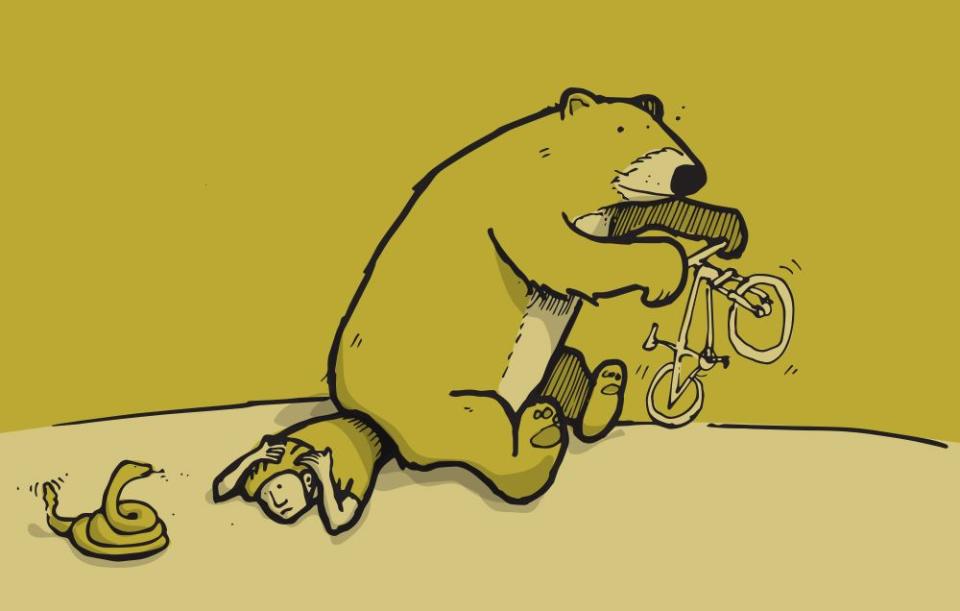This Is How to Survive an Animal Attack on Your Bike

“Hearst Magazines and Verizon Media may earn commission or revenue on some items through the links below.”
Rebecca Rusch doesn’t rattle easily. For more than 20 years, Rusch has rock climbed and adventure raced in remote locales all around the world, and in more than a handful of instances, she’s encountered dangerous wild animals. But none of those experiences were quite as scary as being cornered by a pair of aggressive sheepdogs just five miles from her home in Ketchum, Idaho.
She was alone on a singletrack ride when the sheep herd appeared on the trail. Between the sheep and their guards “was the worst place to be,” she says. And the sheepdogs weren’t small herders. They were 140-pound Great Pyrenees, trained to protect livestock from predators, which they often interpret to include humans. As Rusch tried to circle out of the encounter, the dogs began growling, baring their teeth, and lunging at her.
Rusch’s facedown was thankfully rare, as are most confrontations with wild animals. But it underlines that the greatest threats aren’t the ones that jump to mind first, and that it pays to be prepared. Here’s how to handle it if you come face to face with some of North America’s most dangerous creatures during a bike ride.
→ Get Bicycling All Access for the latest cycling tips!
The Best Confrontation Is the One That Never Happens

Avoid Problem Areas and Times
Mountain lions and snakes are most active at dusk, so plan to be off the trail by then. Large ungulates like moose and elk can be aggressive in fall, during rutting season; and spring, when calves are born. Use situational awareness; if you see signs like fresh scat or tracks, be wary.
Make Noise
Wild animals in particular don’t like surprises, says Darrell Smith, a wildlife biologist with Western Wildlife Outreach. So make noises that animals associate with humans, like speech or singing. “Bear bells don’t really work,” he says bluntly. Even if you surprise an animal, remember that the animal is probably scared too, which works in your favor.
Plan Ahead, and Carry the Right Gear
If you ride in places where you regularly encounter large wildlife, this means carrying the one tool effective at deterring a wide range of animals. No, it’s not a gun—as a 2012 study of more than a century of bear attacks determined, “firearm bearers suffered the same injury rates in close encounters with bears whether they used firearms or not.”
Bear spray, on the other hand, is more effective; a 2008 study found that it’s 90 percent successful in deterring bear attacks, even with grizzlies. And it isn’t just for bears. Smith has used it on elk and moose, and recommends it for cougars and even dogs. To be most effective, it needs to be easily accessible on a belt or holster, like this spray.
Experts recommend bear spray over mace for two reasons. First, bear spray cans have a much longer range (up to 30 feet) and work in a spray rather than a stream, so they’re effective at a distance. Pepper spray is designed for close-range encounters. Second, the concentration of capsaicins and oleoresins is lower in bear spray; it’s intended to irritate and get the animal to leave. Pepper spray is about 5x more concentrated and designed to cause incapacitating pain, which works better on humans than 400-pound bears.
What To Do If You Do Have a Confrontation

You don’t have to remember a lot of variation in handling animal attacks. The main threats in North America are, in no particular order: bears, mountain lions (aka cougars), venomous snakes, dogs, and large ungulates. Moose don’t inspire the natural fear in us that predators do, but don’t be fooled: They’re large and powerful, and can be aggressive.
These techniques hold for almost all animals, with two exceptions: snakes and grizzly bears (more information on those below).
Get Big and Don’t Run
If you have an encounter and the animal stands its ground, don’t run away. “That’s what food does,” says Smith. Make yourself larger by holding your pack or jacket above your head. Shout at the animal. Don’t worry about the old myth about not making eye contact. You need to keep the animal squarely in your field of view, says Smith. Back away slowly, and put your bike between you and the animal. Give it an escape route. Get your spray ready.
Spray Away
If the animal charges or shows signs of aggression, spray a warning blast with the bear spray in their direction. Often, charges are just intended to chase you off. Continue to back away. Spray short blasts if the animal continues to approach, including a direct blast in the face if needed. Don’t worry about wind or rain or conditions that supposedly lessen effectiveness; if you need to use it, use it.
Familiarize yourself with bear spray now, so you know how to use it effectively. Most sprays have a trigger and a safety tab. Know how to aim it. If you shoot the spray over an animal’s head, it’s ineffective; aim slightly downward in front of it. If you test it, don’t do it inside or near people or animals.
Fight Back
In the extremely rare scenario where none of this works, or if you’re attacked by surprise, fight back. Aim for the head, eyes, and neck, and keep hitting and yelling. “Most wildlife knows that if they get injured, it’s bad for them,” says Smith. Only the most determined predator will continue an attack in the face of a sustained and vigorous defense, says Smith.
How to Bikepack Safely in Bear Country:
The Exceptions: How to Survive a Grizzly or Snake Attack

Brown/Grizzly Bears
Brown bears today are found only in Canada and five U.S. states: Alaska, Wyoming, Montana, Idaho, and a small population in Washington. There are two types of encounters: defensive and predatory. In a defensive confrontation, the bear is surprised and defending territory, so do not escalate by shouting or making yourself look big. Do use a normal speaking voice and back away slowly. If charged, use the bear spray, but do not fight back. Instead, lay on your stomach and use your hands to protect your neck. Spread your legs and elbows and resist attempts to flip you over. If the bear does roll you, keep rolling onto your stomach again. In a defensive attack, a bear is trying to end the threat, so lie as still as possible. Only move when you’re sure the bear is gone.
A bear that stalks or follows you is exhibiting predatory behavior. This is extremely rare. In this situation, you do want to look large and intimidating and shout. Throw sticks, stones, whatever you can reach. Use the bear spray, preferably when it’s near the outside range of the spray. If a predatory bear does attack, fight back.
Venomous Snakes
Dealing with snakes is mostly about avoiding them. Bike tires don’t make vibrations like human footfalls do, so make noise if you’re in snake country. If you’re bitten, stay calm, and get back to the trailhead. Don’t panic; snakebite is almost never fatal to adults. Your goal is simply to get out as quickly as possible and get treatment. Clinical study of venom extractors has found them ineffective, and pressure immobilization is not recommended for North American snakebites; the only treatment is antivenom. Call 911 as soon as you’re in cell range; most large hospitals have antivenom for common snakes in your area, and first responders will make sure that you’re taken to a facility that does.
Dogs: The Not-So-Domesticated Case

As Rusch found out, dogs can be a bigger threat than all wildlife. Darrell Smith says that the United States averages about 1.5 deaths a year from large wild carnivore attacks in total. By contrast, about 20 people per year die due to dog bites, according to statistics from the Centers for Disease Control.
Almost all the same techniques that you can use on wildlife work with dogs. Remember: Dogs aren’t always aggressive—sometimes they’re just defending territory. “Step one, if you can, is to outrun them,” says cyclist and dog trainer Jonathan Klein. If you’re on a flat or downhill, you can probably sustain that speed far longer than the dog. But an hour into the climb on a seven-percent grade? “Trying to outrun them is probably not the best plan,” says Klein.
If you can’t outrun them, stop and put your bike between you. “Some hunting breeds, it’s just in their instinct to chase things that are moving, so stopping can defuse the situation,” says Klein. OK, now what? Be the human. Try simple commands like “Go home” and “No.” Don’t challenge the dog with staring and overt posturing. You can also try to distract them with a trick like throwing an imaginary stick—body language they understand.
If you’re attacked, fight back, but with a large breed in full attack mode, you may simply have to curl up and protect your head, neck, and chest. Klein also recommends bear spray, but says the old water-bottle spray trick probably won’t work in a real attack.
Livestock Guardian Dogs like Rusch faced are special cases, says Klein. Rusch didn’t have bear spray, so she did the next best thing. She shouted at them, used her bike as a shield, threw rocks and tried to back away, all to no avail; she still got bitten and the dogs didn’t back off. Eventually, she retreated. “I scrambled down this steep cliff and the herd moved on,” she recalls. Once they were gone, she climbed back up, remounted and rode home, where she reported the attack. “That was important,” she says. “I wanted this on the record. Recreation and herding can share territory, but there are rules.” Treat dogs as you would a wild animal, but if you’re attacked, make sure to report it to authorities.
This story is part of our Worst Case Scenario Guide to Cycling. Check out the next story, “3 Smart Ways Cyclists Can Handle Road Rage.”
You Might Also Like

